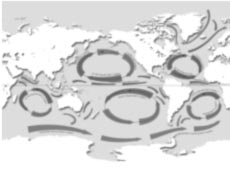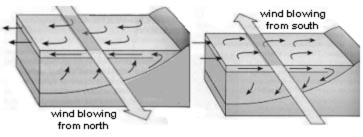1. What primarily drives the surface ocean currents?
a. density differences between water bodies
b. rotation of the Earth on its axis
c. Coriolis forces
d. regional winds patterns

2. In ocean basins, the Coriolis effect helps creates large, circular ocean currents called:
a. gyres.
b. cyclones.
c. typhoons.
d. anticyclones.
3. What drives deep ocean currents?
a. Equatorial waters are more dense, causing seawater to sink into deep ocean basins.
b. Formation of sea ice, increases salinity and the density of seawater, which then sinks into deep ocean basins.
c. Equatorial waters are less dense and warmer, displacing cold water in deep ocean basins.
d. The oceans are stratified by temperature, so surface waters do not sink into deep ocean basins.
4. What consequence does the Coriolis effect have on ocean water currents that are changing latitude?
a. Moving water is deflected to the left in the Northern Hemisphere and to the right in the Southern Hemisphere.
b. Moving water is deflected to the right in the Northern Hemisphere and to the left in the Southern Hemisphere.
c. Moving water is deflected to the right in both hemispheres.
d. Moving water is deflected to the left in both hemispheres.
5. Surface currents involve large masses of water moving horizontally on the surface. Which of the choices below are NOT true?
a. Wind produces both waves and currents.
b. Surface currents occur within the mixing zone.
c. Most ocean current waters move below the pycnocline (the layer of rapidly changing density).
d. Effects of surface currents is to redistribute heat from equatorial to polar regions.
6. Because of the phenomena called Ekman Transport (and Ekman Spiral), which is true about wind and water movement in the Northern Hemisphere?
a. Ocean currents always move in the same direction as the wind is blowing.
b. Ocean currents are deflected
90° to the right.
c. Ocean currents are deflected
90° to the left.
d. Ocean currents move in the opposite direction that the wind is blowing.
7. The current that flows along the East Coast of North America until it is deflected to the right by westerly winds is called the:
a. Gulf Stream.
b. North Atlantic Drift.
c. North Equatorial Current.
d. Florida Current.
8. Only one ocean current flows unimpeded (without obstruction or barriers) around Earth. It is named the:
a. Gulf Stream Current.
b. California Current.
c. Antarctic Circumpolar Current.
d. Aghulas Current.
9.
The large central area of the North Atlantic that has no well-defined currents, and has one of the large, floating garbage patches of the modern world. This part of the ocean is known as the:
a. Red Sea.
b. Dead Sea.
c. Sargasso Sea.
d. North Sea.
10. Where does most deep ocean upwelling usually occur?
a. In the middle of the oceans.
b. Near continents.
c. Near the equator where diverging currents occur.
d. Near the poles where converging currents occur.
11. Under what conditions does coastal upwelling commonly occur?
a. Only where biotic productivity is high enough to sustain it.
b. Only on the eastern coasts of continents.
c. Where winds blow toward shore or Ekman flow carries surface water toward shore.
d. Where winds blow away from shore or Ekman flow carries surface water away from shore.

12. The Coriolis Effect (Ekman Transport) can affect near-shore currents as well as those in the deep ocean. From these graphics, we can see or infer each of the following EXCEPT:
a. winds from the south will bring cold, nutrient-rich waters to the surface.
b. surface currents are deflected to the right of the direction the wind blows.
c. winds from the north create surface currents directed away from the shore.
d. erosion of the shoreline is likely greatest when winds blow from the south because of onshore flow of surface currents and wave action.
13. Based on historical data, how does El Niño conditions generally impact Southern California?
a. Ocean water temperatures are higher (impacting sea life), and there is typically increased rainfall in the rainy season.
b. Ocean water temperatures are lower (impacting sea life), and there is typically increased rainfall in the rainy season.
c. Ocean water temperatures are higher (impacting sea life), and there is typically less rainfall in the rainy season.
d. Ocean water temperatures are lower (impacting sea life), and there is typically less rainfall in the rainy season.
14. Why is the Black Sea experiencing anoxia?
a. The Bosphorus Straight prevents fresh ocean water from entering the Black Sea.
b. There is no mixing zone in the Black Sea.
c. Density stratification of heavier high saline waters prevents oxygen from reaching the seabed.
d. There is no marine life in the Black Sea.
15. Discussed in oceanographic terms, what is a garbage patch?
a. A place where lots of people hang out and garbage is dumped on the beach.
b. Locations in the center of ocean gyres where floating garbage (mostly floating plastic items) accumulates.
c. Places where seagulls flock to feed on garbage.
d. Locations where ocean currents carry trash to the seafloor.
|


